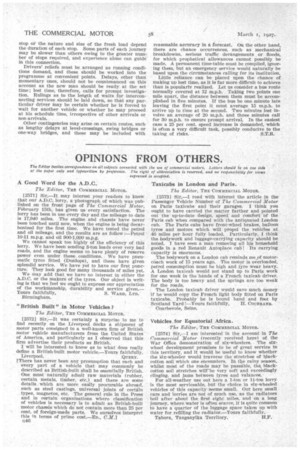OPINIONS FROM OTHERS.
Page 68

If you've noticed an error in this article please click here to report it so we can fix it.
The Editor invites correspondence on all subjects connected with the use of commercial motors. Leiters should be on one side of the 11,215er only and typewritten by preference. The right of abbreviation is reserved, and no responsibility for views
expressed is accepted.
A Good Word for the A.D.C.
The Editor, THE COMMERCIAL MOTOR.
[2571] Sir,—It may interest your readers to know that our A.D.C. lorry, a photograph of which was published on the front page of The Commercial Motor, February 15th, has given us every satisfaction. The lorry has been in use every day and the mileage to date is 17,940 miles. The engine and chassis have never been touched until now, when the engine is being decarbonized for the first time. We have tested the petrol and oil mileage, and the results are as follow :—Petrol 10-11 m.p.g. and oil 900-1,000 m.p.g.
We cannot speak too highly of the efficiency of this lorry. We have been sending 3-ton loads over very bad roads, and the engine seems to have plenty of reserve power even under these conditions. We have pneumatic tyres fitted (Dunlops), and these have given splendid service. We have yet to have our first puncture. They look good for many thousands of miles yet.
We may add that we have no interest in either the A.D.C. or the makers of the tyres. Our object in writing is that we Teel we ought to express our appreciation of the workmanship, durability and service given.—
Yours faithfully, S. WARD, LTD. Birmingham.
"British Built" in Motor Vehicles ?
The Editor, THE COMMERCIAL MOTOR.
[25721 Sir,—It was certainly a surprise to me to find recently on the Liverpool docks a shipment of motor parts consigned to a well-known firm of British motor vehicle manufacturers from the United States of America, and particularly as I observed that this firm advertise their products as British.
I will be interested to know as to what does really define a British-built motor vehicle.—Yours faithfully, Liverpool. QuKev.
[There has never been any presumption that each and every part of a vehicle that may commonly be described as British:built shall be essentially British. One must naturally admit raw materials (rubber, certain metals, timber, etc.) and there are some details which are more easily procurable abroad, such as steel castings, universal joints of certiin types, magnetos, etc. The general rule in the Press and in certain organizations where classification of vehicles is necessary is to admit as British-built motor chassis which do not contain more than 25 per cent, of foreign-made parts. We ourselves interpret this in terms of prime cost—En., C.M.] c46
Taxicabs in London and Paris.
The Editor, THE COMMERCIAL MOTOR.
L25731 Sir,—I read with interest the article in the Paasenger Vehicle Number of The Commercial Motor on Paris taxicabs and their garages. I think you ought to have carried the matter farther and pointed out the up-to-date design, speed and comfort of the Paris cab when compared with the antiquated London cab. The Paris cabs have front-wheel brakes, balloon tyres and motors which will propel the vellidles at 40 miles per hour fully loaded. Particularly, I think the bodywork and luggage-carrS■ing capacity should be noted. I have seen a man removing all his household goods in a red Renault Autoplace cab! Its carrying capacity is enormous.
The bodywork on a London cab reminds me of motorcoach work of 15 years ago. The motor is overloaded, petrol consumption must be high and tyre wear heavy. A London taxicab would not stand up to Paris work for one week in the hands of a French taxicab driver. The body is too heavy and the springs are too weak for the roads.
The London taxicab driver would save much money if he would copy the French light body fitted on Paris taxicabs. Probably he is bound hand and foot by
Scotland Yard !—Yours faithfully, H. COCHRANE. Courbevoie, Seine.
Vehicles for Equatorial Africa.
The Editor, THE COMMERCIAL MOTOR.
[2574] Sir,—I am interested in the account in The Commercial Motor (recently received here) of the War Office demonstration of six-wheelers. The sixwheel development promises to be of great service to this territory, and it would be useful to know whether the Six-wheeler would traverse the stretches of blackcotton soil which one encounters. In the rainy season, whilst most of the roads may be passable, thk blackcotton soil stretches wilrbe very soft and exceedingly clinging, and jams between tyres and valances.
For all-weather use out here a 1-ton or 11-ton lorry is the most serviceable, but the choice in six-wheeled vehicles of this capacity seems small. Out here small cars and lorries are not of much use, as the radiators boil after about the first eight miles, and on a long journey, where water is often scarce, it is quite common to have a quarter of the luggage space taken up with water for refilling the radiator.—Yours faithfully, Tabora, Tanganyika Territory. 11.F.












































































































